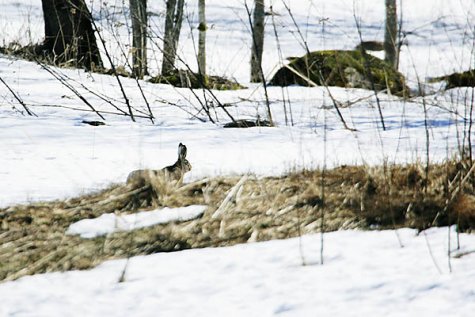Forest hare
Photo: Arne Ader
Translation: Liis
Mountain hare
| Mountain hare, tundra hare |
Valgejänes
|
The mountain hare is a long-time native species in Estonia, that settled here after the Ice Age together with the elk, managing to make do with the available food. Bone finds indicate a period of more than 8 000 years. This year its change of fur ended in November and so was well timed with the coming of the snow. The fur is dense, white, with around 20 000 hairs per square centimetre; the ears have black tips.
If the brown hare is mostly seen in open landscapes, then the mountain hare keeps to forests dominated by conifers; sometimes it is seen moving along the open power lanes there. The mountain hare is quite well adapted to a diet of twigs in winter but in a snowy winter getting at the food is still not easy. It goes foraging at dusk and in night. On the winter menu are the smaller twigs of trees and bushes; shoots, buds, and also the bark: from birch, willows, aspens ... Food requirement is around half a kilo per day. The food is passed through the digestive system twice – read about the brown hare:
Mountain hares prefer forests with good sheltering places. They select their habitats with dense spruce undergrowth, or on the coast, with juniper thickets. They know every bush or fallen tree and all the landscape characteristics of the little home territory, and with reason: they have plenty of enemies: lynxes – with quite similar habitat preferences – and foxes. They can be saved by their quick feet and the trick of doubling back in their own path. The home territory radius is only around 200 – 300 metres; the tracks of a night and day period can be a little above a kilometre long.









